Tips for Teaching Letters


Recognizing letters is the first step to reading and is the foundation for your child’s education. According to the U.S. Department of Education, kindergarteners who are already familiar with letter names typically find it easier to learn to read compared to kids who don’t recognize letters when they start kindergarten. Tips for teaching letters helps your child learn to read faster, you can use a few proven strategies that will increase their letter recognition.
Knowledge of letters and the alphabet
Research has shown that one of the best predictors of reading achievement for first-year readers is their ability to identify both upper and lower case letters. For younger children, you can begin by reading aloud to your child every day and providing letters to play with, such as letter puzzles or magnetic letters that stick to the refrigerator.
Make sure that your child is in the right mood to learn since a tired, grumpy, or hungry child will likely not be willing to focus on letters. Consonants should be introduced first, since they are typically easier for children to learn and are more consistent in the sounds they make compared to vowels, which can change their sounds depending on the word. Try to keep a steady pace when teaching letters to your child, while making sure the pace is not too slow.
One tried and true method is to teach only one or a few letters at a time so your child does not get confused, and move on only when your child indicates readiness. Provide your child with numerous opportunities to practice recognizing letters, writing letters if they are ready, and understanding how letters make sounds to form words. Sound games and word games are excellent tools to help a child learn to recognize letters.
The U.S. Department of Education also recommends:
Giving your child blocks or plastic alphabet tiles, and encouraging him or her to spell familiar names or favorite words.
Emphasizing the different sounds letters make.
Practicing writing letters with your child.
Encouraging your child to experiment and play with letters to become more familiar with them.
Making learning about letters fun by playing games.
Sources:
- The Florida Reading Quarterly
- Critical Components in Early Literacy — Knowledge of the Letters of the Alphabet and Phonics Instruction.
U.S - Department of Education
- Teaching our Youngest: A Guide for Preschool Teachers and Child Care and Family Providers.
Powered by Bundoo®










































